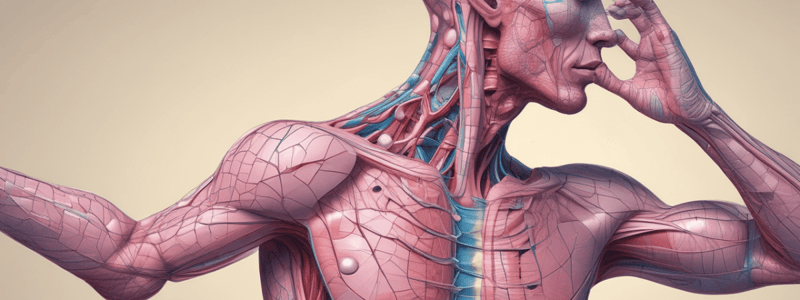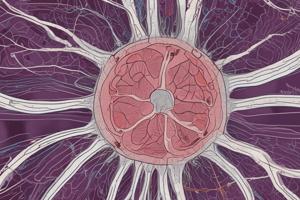Podcast
Questions and Answers
What is the primary function of connective tissue?
What is the primary function of connective tissue?
- To provide a source of energy for cells
- To produce proteins and other biomolecules
- To regulate body temperature
- To physically support and connect other tissues and maintain the water required for metabolite diffusion (correct)
What is the main characteristic of connective tissues?
What is the main characteristic of connective tissues?
- They are found only in the musculoskeletal system
- They are composed primarily of cells
- They consist primarily of extracellular material (correct)
- They are responsible for producing hormones
What is the role of the stroma in organs?
What is the role of the stroma in organs?
- It provides a barrier against infection
- It aids in the digestion of nutrients
- It is responsible for producing hormones
- It supports the organ's unique functional components or parenchyma (correct)
What is the composition of the ECM in connective tissue proper?
What is the composition of the ECM in connective tissue proper?
From which embryonic form of connective tissue do all adult connective tissues derive?
From which embryonic form of connective tissue do all adult connective tissues derive?
What is the primary function of fibroblasts in connective tissue?
What is the primary function of fibroblasts in connective tissue?
Which type of connective tissue is specialized for storage of triglycerides?
Which type of connective tissue is specialized for storage of triglycerides?
What is the primary function of macrophages in connective tissue?
What is the primary function of macrophages in connective tissue?
Which type of cells are short-lived and differentiate from B lymphocytes?
Which type of cells are short-lived and differentiate from B lymphocytes?
What is the primary function of mast cells in connective tissue?
What is the primary function of mast cells in connective tissue?
Which cells are responsible for providing surveillance against bacterial invaders and stimulating tissue repair?
Which cells are responsible for providing surveillance against bacterial invaders and stimulating tissue repair?
What is the origin of macrophages in connective tissue?
What is the origin of macrophages in connective tissue?
What is the characteristic pattern produced by the regular assembly of collagens in fibrils?
What is the characteristic pattern produced by the regular assembly of collagens in fibrils?
Which type of collagen produces a network of delicate reticular fibers?
Which type of collagen produces a network of delicate reticular fibers?
What is the function of collagenase enzymes in the context of collagen?
What is the function of collagenase enzymes in the context of collagen?
What is the result of the exocytosis of procollagen subunits?
What is the result of the exocytosis of procollagen subunits?
What is the role of fibroblasts in the synthesis of collagen?
What is the role of fibroblasts in the synthesis of collagen?
What is the result of the bundling of collagen fibrils of type I collagen?
What is the result of the bundling of collagen fibrils of type I collagen?
What is the primary component of elastic fibers?
What is the primary component of elastic fibers?
What is the unique property of elastic lamellae?
What is the unique property of elastic lamellae?
What type of connective tissue is rich in elastic fibers?
What type of connective tissue is rich in elastic fibers?
What is the function of elastin and fibrillin in elastic fibers?
What is the function of elastin and fibrillin in elastic fibers?
What is the characteristic of elastic fibers that allows them to provide elasticity to connective tissues?
What is the characteristic of elastic fibers that allows them to provide elasticity to connective tissues?
What is the primary component of ground substance in connective tissue proper?
What is the primary component of ground substance in connective tissue proper?
What is the function of linker proteins in ground substance?
What is the function of linker proteins in ground substance?
Where are sulfated GAGs produced in the cell?
Where are sulfated GAGs produced in the cell?
What is the result of the binding of proteoglycans to polymers of HA in ground substance?
What is the result of the binding of proteoglycans to polymers of HA in ground substance?
What is the main component of hyaluronan?
What is the main component of hyaluronan?
What is the primary characteristic of loose connective tissue?
What is the primary characteristic of loose connective tissue?
Which type of connective tissue is characterized by bundles of essentially parallel type I collagen?
Which type of connective tissue is characterized by bundles of essentially parallel type I collagen?
What is the primary function of reticular tissue?
What is the primary function of reticular tissue?
Where is mucoid tissue most abundant?
Where is mucoid tissue most abundant?
What is the characteristic of dense irregular connective tissue?
What is the characteristic of dense irregular connective tissue?
What is the primary component of dense regular connective tissue?
What is the primary component of dense regular connective tissue?
What is the result of the arrangement of collagen in dense regular connective tissue?
What is the result of the arrangement of collagen in dense regular connective tissue?
Flashcards are hidden until you start studying
Study Notes
Connective Tissue
- Specialized to provide physical support and connection to other tissues, and maintain water required for metabolite diffusion to and from cells.
- Composed primarily of extracellular material rather than cells.
- Forms the supportive stroma within most organs, supporting the organ's unique functional components or parenchyma.
- Extracellular matrix (ECM) consists of both large protein fibers and nonfibrous areas of unstained ground substance rich in various Glycosaminoglycans (GAGs) and water.
- All adult connective tissues originate from an embryonic form of connective tissue called mesenchyme.
- Mesenchyme contains uniformly undifferentiated cells scattered in a gel-like matrix.
Cells of Connective Tissue
- Fibroblasts (fibrocytes) are the major cells of connective tissue proper, characterized by:
- Elongated, irregularly shaped cells with oval nuclei
- Synthesize and secrete most components of the extracellular matrix (ECM)
- Adipocytes (fat cells) are specialized cells for storage of triglycerides, found in:
- Adipose tissue, a specialized form of connective tissue
- Very large cells
- Macrophages are short-lived cells that:
- Differentiate in connective tissue from precursor cells called monocytes
- Function in:
- ECM turnover
- Phagocytosis of dead cells and debris
- Antigen presentation to lymphocytes
- Mast cells originate from blood cell precursors and:
- Contain granules for the release of various vasoactive agents and other substances during:
- Inflammatory reactions
- Allergic reactions
- Contain granules for the release of various vasoactive agents and other substances during:
- Plasma cells are short-lived cells that:
- Differentiate from B lymphocytes
- Specialized for the abundant secretion of specific antibodies (immunoglobulins)
- Leukocytes, including macrophages and plasma cells, normally wander through all types of connective tissue proper, providing:
- Surveillance against bacterial invaders
- Stimulation of tissue repair
Collagen Synthesis
- Collagen synthesis involves posttranslational modifications in the Rough Endoplasmic Reticulum (RER)
- Hydroxylation of prolines and lysines occurs in the RER
- Helical trimeric subunits of procollagen are formed in the RER
Collagen Formation
- Procollagen subunits are exocytosed and nonhelical ends are removed, forming trimeric collagen molecules
- Trimeric collagen molecules aggregate and become covalently bound together to form large collagen fibrils
- The highly regular assembly of collagens produces a characteristic pattern of crossbanding visible ultrastructurally
Collagen Fibril Structure
- Fibrils of type I collagen are bundled together by nonfibrillar, linking collagens to produce large collagen bundles
- Collagen fibrils are composed of trimeric collagen molecules covalently bound together
Collagen Degradation
- Collagen fibrils are degraded by collagenase enzymes classified as Matrix Metalloproteinases (MMPs)
- MMPs are primarily produced by macrophages
Specialty Collagen Types
- Type III collagen produces a network of delicate reticular fibers
- Reticular fibers stain very dark with silver stains
- Reticular fibers are abundant in immune and lymphoid tissues
Elastic Fibers
- Elastic fibers are composed of two main proteins: elastin and fibrillin.
- These proteins exist in a stretchable conformation, giving elastic properties to connective tissues.
- The elastic properties are due to the stretchable conformation of elastin and fibrillin.
- Elastic fibers are also known as elastic lamellae, which are sheets of elastic fibers.
- Connective tissues that are rich in elastic fibers have elastic properties due to the presence of these proteins.
Ground Substance
- Ground substance is the watery, unstained extracellular material that is more abundant than fibers in some types of connective tissue proper.
Composition of Ground Substance
- Rich in hydrated GlycosAminoGlycans (GAGs), proteoglycans, and multiadhesive glycoproteins.
- Major types of GAGs include:
- Hyaluronan (hyaluronic acid), a very long polymer of the disaccharide glucosamine-glucuronate.
- Various shorter chains of sulfated GAGs composed of other disaccharide polymers.
Sulfated GAGs
- Examples include chondroitin sulfate and keratan sulfate.
- Vary in size and composition, but are all bound to the core proteins of proteoglycans.
- Produced in the Golgi apparatus before secretion.
Proteoglycans
- Attach to polymers of hyaluronan (HA) via linker proteins.
- Form huge complexes in ground substance that:
- Bind water and other substances.
- Bind certain polypeptide growth factors that help regulate fibroblast proliferation.
Types of Connective Tissue
- Connective tissue is classified as loose or dense based on the amount of collagen and ground substance present.
Loose Connective Tissue
- Also known as areolar tissue
- Has relatively more ground substance than collagen
- Typically surrounds small blood vessels and occupies areas adjacent to other types of epithelia
Dense Connective Tissue
- Has two subtypes: irregular and regular
- Dense irregular connective tissue:
- Filled primarily with randomly distributed bundles of type I collagen
- Has some elastic fibers, providing resistance to tearing from all directions and some elasticity
- Dense regular connective tissue:
- Found in tendons and ligaments
- Features bundles of essentially parallel type I collagen
- Provides great strength (but little stretch) in binding together components of the musculoskeletal system
Specialized Connective Tissue
- Reticular tissue:
- Consists of delicate networks of type III collagen
- Most abundant in certain lymphoid organs
- Fibers form attachment sites for lymphocytes and other immune cells
- Mucoid tissue:
- A gel-like connective tissue with few cells
- Found most abundantly around blood vessels in the umbilical cord
Studying That Suits You
Use AI to generate personalized quizzes and flashcards to suit your learning preferences.




